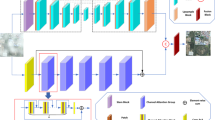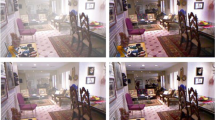Abstract
Image dehazing aims to recover a clean image from a hazy image, which is a challengingly longstanding problem. In this paper, we propose an Ensemble Multi-scale Residual Attention Network (EMRA-Net) to directly generate a clean image, which include two parts: a three-scale residual attention CNN (TRA-CNN), and an ensemble attention CNN (EA-CNN). In TRA-CNN, we employ wavelet transform to obtain the downsampled images, instead of using common spatial downsampling methods, such as nearest downsampling and strided-convolution. With the help of wavelet transform, we can avoid the loss of image texture details. Moreover, in each scale-branch, Res2Net modules are connected in series to make full use of the hierarchical features from the original hazy images, and channel attention mechanism is introduced to focus channel-dimension information. Finally, an EA-CNN is proposed to fuse coarse images generated from TRA-CNN into a refined clean image. Extensive experiments on the benchmark synthetic hazy datasets and the real-world hazy dataset prove that proposed EMRA-Net is superior to previous state-of-the-art methods both in subjective visual perception and objective image quality assessment metrics.














Similar content being viewed by others
Data availability
Not applicable.
References
Ancuti C, Ancuti C O, De Vleeschouwer C (2016) D-HAZY: a dataset to evaluate quantitatively dehazing algorithms. In IEEE international conference on image processing (ICIP), Phoenix, AZ, USA, pp. 2226–2230
Berman D, Avidan S (2016) Non-local image Dehazing. In Proceedings of the IEEE Conference on Computer Vision and Pattern Recognition, pp 1674–1682
Blau Y, Mechrez R, Timofte R, Michaeli T, Zelnik-Manor L (2018) The 2018 PIRM challenge on perceptual image super-resolution. arXiv:1809.07517
Cai B, Xu X, Jia K, Qing C, Tao D (2016) DehazeNet: an end-to-end system for single image haze removal. IEEE Trans Image Process 25(11):5187–5198
Dong Y, Liu Y, Zhang H, Chen S, Qiao Y (2020) FD-GAN: generative adversarial networks with fusion-discriminator for single image Dehazing. In AAAI, New York City, NY, USA, pp. 10729–10736
Engin D, Genç A, Kemal Ekenel H (2018) Cycle-Dehaze: enhanced CycleGAN for single image Dehazing. In Proceedings of the IEEE conference on computer vision and pattern recognition workshops, Salt Lake City, UT, USA, pp. 825–833
Fattal R (2014) Dehazing using color-lines. ACM Trans Graph 34(1):1–14
Gao S, Cheng MM, Zhao K, Zhang XY, Yang MH, Torr PH (2019) Res2Net: a new multi-scale backbone architecture. IEEE Trans Pattern Anal Mach Intell 43(2):652–662
Goodfellow I, Pouget-Abadie J, Mirza M, Xu B, Warde-Farley D, Ozair S, Courville A, Bengio Y (2014) Generative adversarial networks. In Proceedings of the 27th international conference on neural information processing systems, Montreal, Quebec, Canada, pp. 2672–2680
Guo T, Seyed Mousavi H, Huu Vu T, Monga V (2017) Deep wavelet prediction for image super-resolution. In Proceedings of the IEEE Conference on Computer Vision and Pattern Recognition Workshops, Honolulu, HI, USA, pp. 104–113
He K, Sun J, Tang X (2010) Single image haze removal using Dark Channel prior. IEEE Trans Pattern Anal Mach Intell 33(12):2341–2353
Hu J, Shen L, Sun G (2018) Squeeze-and-excitation networks. In Proceedings of the IEEE Conference on Computer Vision and Pattern Recognition, Salt Lake City, UT, USA, pp. 7132–7141
Kingma D P, Ba J (2015) Adam: A method for stochastic optimization. arXiv:1412.6980
Kumar A (2019) Design of Secure Image Fusion Technique Using Cloud for privacy-preserving and copyright protection. International Journal of Cloud Applications and Computing (IJCAC) 9(3):22–36
Ledig C, Theis L, Huszár F, Caballero J, Cunningham A, Acosta A, Aitken A, Tejani A, Totz J, Wang Z, Shi W (2017) Photo-realistic single image super-resolution using a generative adversarial network. In Proceedings of the IEEE Conference on Computer Vision and Pattern Recognition, Honolulu, HI, USA, pp. 4681–4690
Li B, Peng X, Wang Z, Xu J, Feng D (2017) AOD-net: all-in-one Dehazing network. In Proceedings of the IEEE International Conference on Computer Vision, Venice, Italy, pp. 4770–4778
Li R, Pan J, Li Z, Tang J (2018) Single image Dehazing via conditional generative adversarial network. In Proceedings of the IEEE Conference on Computer Vision and Pattern Recognition, Salt Lake City, UT, USA, pp. 8202–8211
Li B, Ren W, Fu D, Tao D, Feng D, Zeng W, Wang Z (2018) Benchmarking Single-Image Dehazing and Beyond. IEEE Trans Image Process 28(1):492–505
Li D, Deng L, Gupta BB, Wang H, Choi C (2019) A novel CNN based security guaranteed image watermarking generation scenario for smart city applications. Inf Sci 479:432–447
Lin T Y, Dollár P, Girshick R, He K, Hariharan B, Belongie S (2017) Feature pyramid networks for object detection. In Proceedings of the IEEE Conference on Computer Vision and Pattern Recognition, Honolulu, HI, USA, pp. 2117–2125
Ma C, Yang CY, Yang X, Yang MH (2017) Learning a no-reference quality metric for single-image super-resolution. Comput Vis Image Underst 158:1–16
Mei K, Jiang A, Li J, Wang M (2018) Progressive feature fusion network for realistic image Dehazing. In Asian Conference on Computer Vision, Perth, Australia, pp. 203–215
Mittal A, Soundararajan R, Bovik AC (2012) Making a “completely blind” image quality analyzer. IEEE Signal Processing Letters 20(3):209–212
Nah S, Hyun Kim T, Mu Lee K (2017) Deep multi-scale convolutional neural network for dynamic Deblurring. In Proceedings of the IEEE Conference on Computer Vision and Pattern Recognition, Honolulu, HI, USA, pp. 3883–3891
Narasimhan SG, Nayar SK (2000) Chromatic framework for vision in bad weather. In proceedings of the IEEE conference on computer vision and pattern recognition, Hilton Head Island, SC, USA, 1:598-605
Narasimhan SG, Nayar SK (2002) Vision and the atmosphere. Int J Comput Vis 48(3):233–254
Qu Y, Chen Y, Huang J, Xie Y (2019) Enhanced Pix2pix Dehazing network. In Proceedings of the IEEE conference on computer vision and pattern recognition, Long Beach, CA, USA, pp. 8160–8168
Ren W, Liu S, Zhang H, Pan J, Cao X, Yang MH (2016) Single image Dehazing via multi-scale convolutional neural networks. In proceedings of the European conference on computer vision, Amsterdam, the Netherlands, pp. 154-169
Ren W, Ma L, Zhang J, Pan J, Cao X, Liu W, Yang M H (2018) Gated fusion network for single image Dehazing. In Proceedings of the IEEE conference on computer vision and pattern recognition, Salt Lake City, UT, USA, pp. 3253–3261
Scharstein D, Szeliski R (2003) High-accuracy stereo depth maps using structured light. In IEEE computer society conference on computer vision and pattern recognition, Madison, WI, USA, pp. I-I
Silberman N, Hoiem D, Kohli P, Fergus R (2012) Indoor segmentation and support inference from RGBD images. In Proceedings of the European Conference on Computer Vision, Firenze, Italy, pp. 746–760
Tan RT (2008) Visibility in bad weather from a single image. In Proceedings of the IEEE Conference on Computer Vision and Pattern Recognition, pp 1–8
Wang F, Jiang M, Qian C, Yang S, Li C, Zhang H, Wang X, Tang X (2017) Residual attention network for image classification. In Proceedings of the IEEE Conference on Computer Vision and Pattern Recognition, Honolulu, HI, USA, pp. 3156–3164
Wang T C, Liu M Y, Zhu J Y, Tao A, Kautz J, Catanzaro B (2018) High-resolution image synthesis and semantic manipulation with conditional GANs. In Proceedings of the IEEE Conference on Computer Vision and Pattern Recognition, Salt Lake City, UT, USA, pp. 8798–8807
Wang H, Li Z, Li Y, Gupta BB, Choi C (2020) Visual saliency guided complex image retrieval. Pattern Recogn Lett 130:64–72
Wu Q, Ren W, Cao X (2019) Learning interleaved Cascade of shrinkage fields for joint image Dehazing and Denoising. IEEE Trans Image Process 29:1788–1801
Yang H H, Fu Y (2019) Wavelet U-net and the chromatic adaptation transform for single image Dehazing. In IEEE international conference on image processing (ICIP), Taipei, Taiwan, China, pp. 2736–2740
Yang D, Sun J (2018) Proximal Dehaze-net: a prior learning-based deep network for single image Dehazing. In Proceedings of the European conference on computer vision, Munich, Germany, pp. 702–717
Yang X, Xu Z, Luo J (2018) Towards perceptual image Dehazing by physics-based disentanglement and adversarial training. In AAAI, New Orleans, LA, USA, pp. 7485–7492
Yang H H, Yang C H H, Tsai Y C J (2020) Y-net: multi-scale feature aggregation network with wavelet structure similarity loss function for single image Dehazing. In IEEE International Conference on Acoustics, Speech and Signal Processing (ICASSP), Barcelona, Spain, pp. 2628–2632
Zhang H, Patel V M (2018) Densely connected pyramid Dehazing network. In Proceedings of the IEEE conference on computer vision and pattern recognition, Salt Lake City, UT, USA, pp. 3194–3203
Zhang Y, Ding L, Sharma G (2017) HazeRD: an outdoor scene dataset and benchmark for single image dehazing. In IEEE international conference on image processing (ICIP), Beijing, China, pp. 3205–3209
Zhang X, Wang T, Qi J, Lu H, Wang G (2018) Progressive attention guided recurrent network for salient object detection. In Proceedings of the IEEE conference on computer vision and pattern recognition, Salt Lake City, UT, USA, pp. 714–722
Zhu Q, Mai J, Shao L (2015) A fast single image haze removal algorithm using color attenuation prior. IEEE Trans Image Process 24(11):3522–3533
Zhu J Y, Park T, Isola P, Efros A A (2017) Unpaired image-to-image translation using cycle-consistent adversarial networks. In Proceedings of the IEEE international conference on computer vision, Venice, Italy, pp. 2223–2232
Acknowledgments
This work was supported by the National Natural Science Foundation of China (No. 61771223).
Code availability
Applicable.
Funding
This study was funded by National Natural Science Foundation of China (No. 61771223).
Author information
Authors and Affiliations
Corresponding author
Ethics declarations
Conflicts of interest/competing interests
The authors declare that they have no conflict of interest.
Additional information
Publisher’s note
Springer Nature remains neutral with regard to jurisdictional claims in published maps and institutional affiliations.
Rights and permissions
About this article
Cite this article
Wang, J., Li, C. & Xu, S. An ensemble multi-scale residual attention network (EMRA-net) for image Dehazing. Multimed Tools Appl 80, 29299–29319 (2021). https://doi.org/10.1007/s11042-021-11081-x
Received:
Revised:
Accepted:
Published:
Issue Date:
DOI: https://doi.org/10.1007/s11042-021-11081-x




